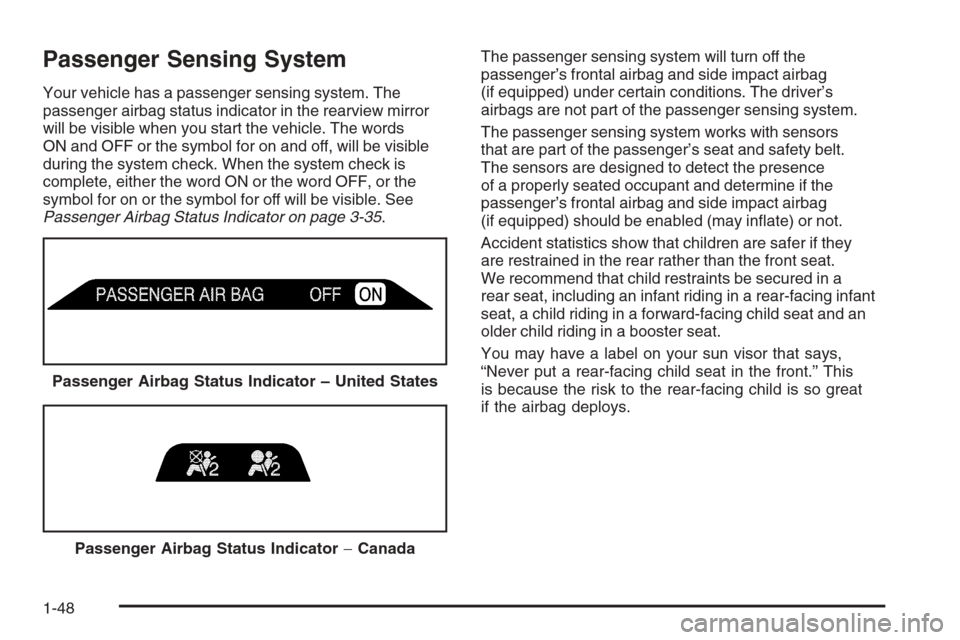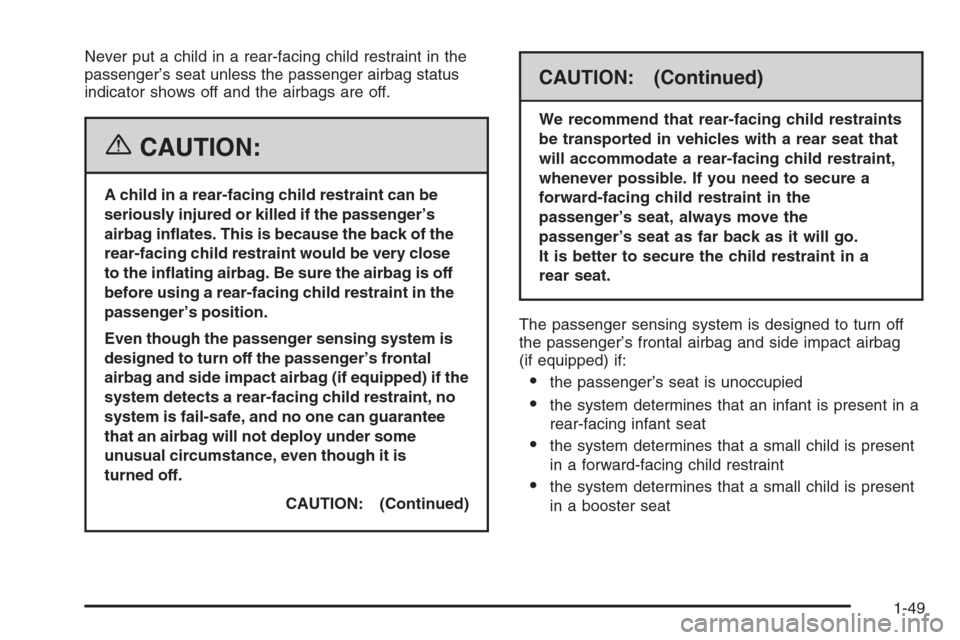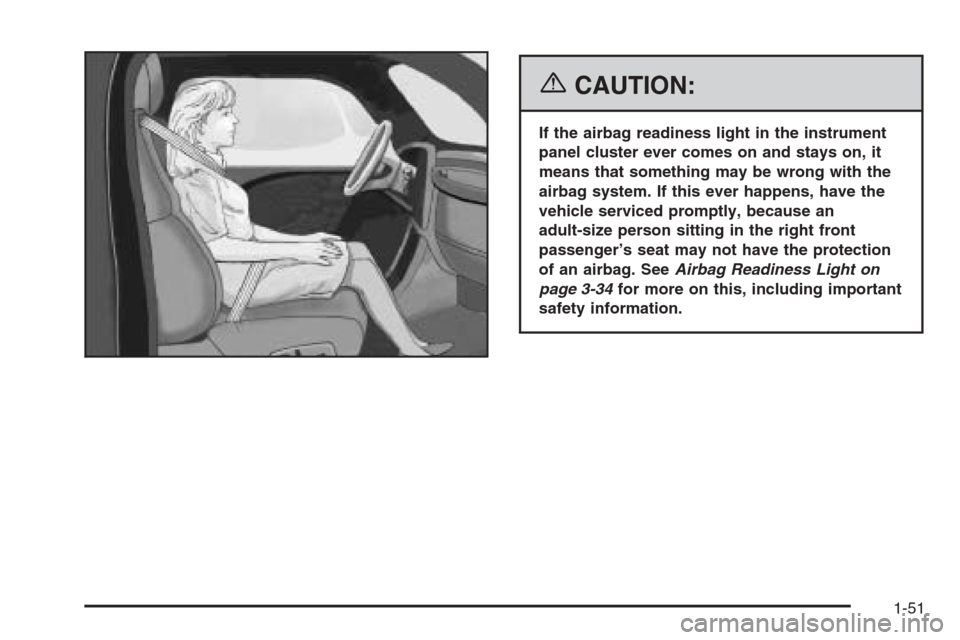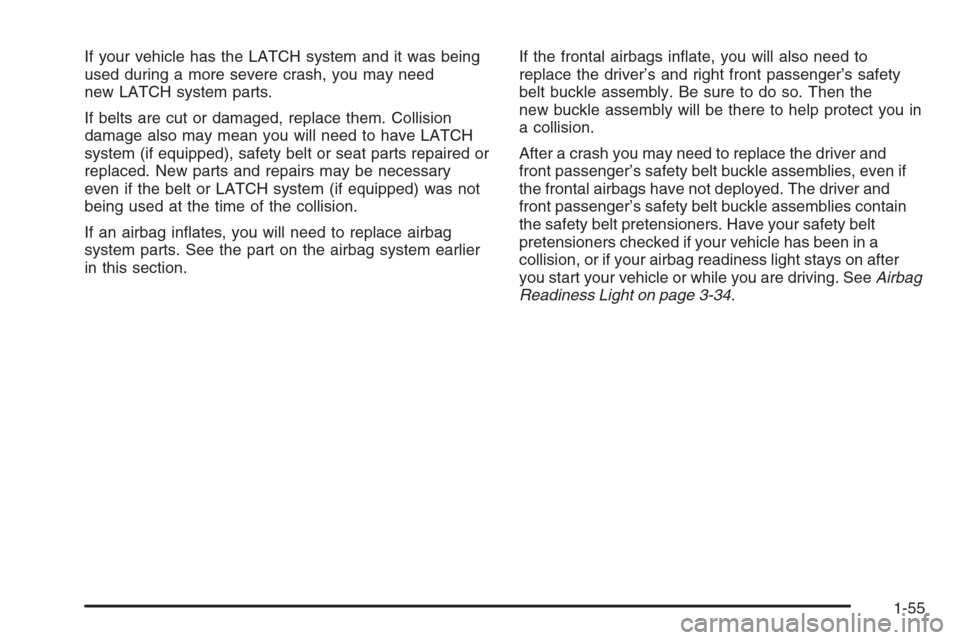2006 CHEVROLET CORVETTE airbag
[x] Cancel search: airbagPage 54 of 426

Passenger Sensing System
Your vehicle has a passenger sensing system. The
passenger airbag status indicator in the rearview mirror
will be visible when you start the vehicle. The words
ON and OFF or the symbol for on and off, will be visible
during the system check. When the system check is
complete, either the word ON or the word OFF, or the
symbol for on or the symbol for off will be visible. See
Passenger Airbag Status Indicator on page 3-35.The passenger sensing system will turn off the
passenger’s frontal airbag and side impact airbag
(if equipped) under certain conditions. The driver’s
airbags are not part of the passenger sensing system.
The passenger sensing system works with sensors
that are part of the passenger’s seat and safety belt.
The sensors are designed to detect the presence
of a properly seated occupant and determine if the
passenger’s frontal airbag and side impact airbag
(if equipped) should be enabled (may in�ate) or not.
Accident statistics show that children are safer if they
are restrained in the rear rather than the front seat.
We recommend that child restraints be secured in a
rear seat, including an infant riding in a rear-facing infant
seat, a child riding in a forward-facing child seat and an
older child riding in a booster seat.
You may have a label on your sun visor that says,
“Never put a rear-facing child seat in the front.” This
is because the risk to the rear-facing child is so great
if the airbag deploys. Passenger Airbag Status Indicator – United States
Passenger Airbag Status Indicator−Canada
1-48
Page 55 of 426

Never put a child in a rear-facing child restraint in the
passenger’s seat unless the passenger airbag status
indicator shows off and the airbags are off.
{CAUTION:
A child in a rear-facing child restraint can be
seriously injured or killed if the passenger’s
airbag in�ates. This is because the back of the
rear-facing child restraint would be very close
to the in�ating airbag. Be sure the airbag is off
before using a rear-facing child restraint in the
passenger’s position.
Even though the passenger sensing system is
designed to turn off the passenger’s frontal
airbag and side impact airbag (if equipped) if the
system detects a rear-facing child restraint, no
system is fail-safe, and no one can guarantee
that an airbag will not deploy under some
unusual circumstance, even though it is
turned off.
CAUTION: (Continued)
CAUTION: (Continued)
We recommend that rear-facing child restraints
be transported in vehicles with a rear seat that
will accommodate a rear-facing child restraint,
whenever possible. If you need to secure a
forward-facing child restraint in the
passenger’s seat, always move the
passenger’s seat as far back as it will go.
It is better to secure the child restraint in a
rear seat.
The passenger sensing system is designed to turn off
the passenger’s frontal airbag and side impact airbag
(if equipped) if:
the passenger’s seat is unoccupied
the system determines that an infant is present in a
rear-facing infant seat
the system determines that a small child is present
in a forward-facing child restraint
the system determines that a small child is present
in a booster seat
1-49
Page 56 of 426

a passenger takes his/her weight off of the seat for
a period of time
the passenger’s seat is occupied by a smaller
person, such as a child who has outgrown
child restraints
or if there is a critical problem with the airbag
system or the passenger sensing system
When the passenger’s frontal airbag and side impact
airbag (if equipped) have been turned off by the
passenger sensing system, the off indicator will light
and stay lit to remind you that the airbags are off.
If a child restraint has been installed and the on indicator
is lit, turn the vehicle off. Remove the child restraint
from the vehicle and reinstall the child restraint following
the child restraint manufacturer’s directions and refer
toSecuring a Child Restraint in the Passenger
Seat Position on page 1-35.
If after reinstalling the child restraint and restarting the
vehicle, the on indicator is still lit, check to make sure
that the vehicle’s seatback is not pressing the child
restraint into the seat cushion. If this happens, slightly
recline the vehicle’s seatback and adjust the seat
cushion if possible.
If the on indicator is still lit, do not secure the child
restraint in this vehicle and check with your dealer.The passenger sensing system is designed to enable
(may in�ate) the passenger’s frontal airbag and
side impact airbag (if equipped) anytime the system
senses that a person of adult size is sitting properly in
the passenger’s seat. When the passenger sensing
system has allowed the airbags to be enabled, the on
indicator will light and stay lit to remind you that the
airbags are active.
For some children who have outgrown child restraints
and for very small adults, the passenger sensing system
may or may not turn off the passenger’s frontal airbag
and side impact airbag (if equipped), depending upon
the person’s seating posture and body build. Everyone
in your vehicle who has outgrown child restraints should
wear a safety belt properly — whether or not there is an
airbag for that person.
If a person of adult-size is sitting in the passenger’s
seat, but the off indicator is lit, it could be because that
person is not sitting properly in the seat. If this happens,
turn the vehicle off and ask the person to place the
seatback in the fully upright position, then sit upright in
the seat, centered on the seat cushion, with the person’s
legs comfortably extended. Restart the vehicle and have
the person remain in this position for about two minutes.
This will allow the system to detect that person and then
enable the passenger’s frontal airbag and side impact
airbag (if equipped).
1-50
Page 57 of 426

{CAUTION:
If the airbag readiness light in the instrument
panel cluster ever comes on and stays on, it
means that something may be wrong with the
airbag system. If this ever happens, have the
vehicle serviced promptly, because an
adult-size person sitting in the right front
passenger’s seat may not have the protection
of an airbag. SeeAirbag Readiness Light on
page 3-34for more on this, including important
safety information.
1-51
Page 58 of 426

Aftermarket equipment, such as seat covers, can affect
how well the passenger sensing system operates.
You may want to consider not using seat covers or other
aftermarket equipment if your vehicle has the passenger
sensing system. SeeAdding Equipment to Your
Airbag-Equipped Vehicle on page 1-53for more
information about modi�cations that can affect how the
system operates.
{CAUTION:
Stowing of articles under the passenger’s seat
or between the passenger’s seat cushion
and seatback may interfere with the proper
operation of the passenger sensing system.
Servicing Your Airbag-Equipped
Vehicle
Airbags affect how your vehicle should be serviced.
There are parts of the airbag system in several places
around your vehicle. You do not want the system to
in�ate while someone is working on your vehicle.
Your dealer and the service manual have information
about servicing your vehicle and the airbag system.
To purchase a service manual, seeService Publications
Ordering Information on page 7-14.
{CAUTION:
For up to 10 seconds after the ignition key is
turned off and the battery is disconnected, an
airbag can still in�ate during improper service.
You can be injured if you are close to an airbag
when it in�ates. Avoid yellow connectors. They
are probably part of the airbag system. Be sure
to follow proper service procedures, and make
sure the person performing work for you is
quali�ed to do so.
The airbag system does not need regular maintenance.
1-52
Page 59 of 426

Adding Equipment to Your
Airbag-Equipped Vehicle
Q:Is there anything I might add to the front or
sides of the vehicle that could keep the
airbags from working properly?
A:Yes. If you add things that change your vehicle’s
frame, bumper system, height, front end or side
sheet metal, they may keep the airbag system
from working properly. Also, the airbag system may
not work properly if you relocate any of the airbag
sensors. If you have any questions about this,
you should contact Customer Assistance before
you modify your vehicle. The phone numbers
and addresses for Customer Assistance are in
Step Two of the Customer Satisfaction Procedure
in this manual. SeeCustomer Satisfaction
Procedure on page 7-2.
Q:Because I have a disability, I have to get my
vehicle modi�ed. How can I �nd out whether
this will affect my advanced airbag system?
A:Changing or moving any parts of the front seats,
safety belts, the airbag sensing and diagnostic
module, steering wheel, instrument panel, the inside
review mirror, or airbag wiring can affect the
operation of the airbag system. If you have
questions, call Customer Assistance. The phone
numbers and addresses for Customer Assistance
are in Step Two of the Customer Satisfaction
Procedure in this manual. SeeCustomer Satisfaction
Procedure on page 7-2.
1-53
Page 60 of 426

Restraint System Check
Checking the Restraint Systems
Now and then, make sure the safety belt reminder light
and all your belts, buckles, latch plates, retractors
and anchorages are working properly. Look for any other
loose or damaged safety belt system parts. If you see
anything that might keep a safety belt system from doing
its job, have it repaired. SeeCare of Safety Belts on
page 5-85.
Torn or frayed safety belts may not protect you in a
crash. They can rip apart under impact forces. If a belt
is torn or frayed, get a new one right away.
Also look for any opened or broken airbag covers, and
have them repaired or replaced. The airbag system
does not need regular maintenance.
Notice:If you damage the covering for the driver’s
or the right front passenger’s frontal airbag, or
an airbag covering (if equipped) on a seatback, the
airbag may not work properly. You may have to
replace the airbag module in the steering wheel,
both the airbag module and the instrument panel for
the right front passenger’s frontal airbag, or both
the airbag module and the seatback for seating
positions with a side impact airbag (if equipped.)
Do not open or break the airbag coverings.
Replacing Restraint System Parts
After a Crash
{CAUTION:
A crash can damage the restraint systems in
your vehicle. A damaged restraint system
may not properly protect the person using it,
resulting in serious injury or even death in a
crash. To help make sure your restraint
systems are working properly after a crash,
have them inspected and any necessary
replacements made as soon as possible.
If you have had a crash, do you need new belts or
LATCH system (if equipped) parts?
After a very minor collision, nothing may be necessary.
But if the belts were stretched, as they would be if worn
during a more severe crash, then you need new parts.
1-54
Page 61 of 426

If your vehicle has the LATCH system and it was being
used during a more severe crash, you may need
new LATCH system parts.
If belts are cut or damaged, replace them. Collision
damage also may mean you will need to have LATCH
system (if equipped), safety belt or seat parts repaired or
replaced. New parts and repairs may be necessary
even if the belt or LATCH system (if equipped) was not
being used at the time of the collision.
If an airbag in�ates, you will need to replace airbag
system parts. See the part on the airbag system earlier
in this section.If the frontal airbags in�ate, you will also need to
replace the driver’s and right front passenger’s safety
belt buckle assembly. Be sure to do so. Then the
new buckle assembly will be there to help protect you in
a collision.
After a crash you may need to replace the driver and
front passenger’s safety belt buckle assemblies, even if
the frontal airbags have not deployed. The driver and
front passenger’s safety belt buckle assemblies contain
the safety belt pretensioners. Have your safety belt
pretensioners checked if your vehicle has been in a
collision, or if your airbag readiness light stays on after
you start your vehicle or while you are driving. SeeAirbag
Readiness Light on page 3-34.
1-55